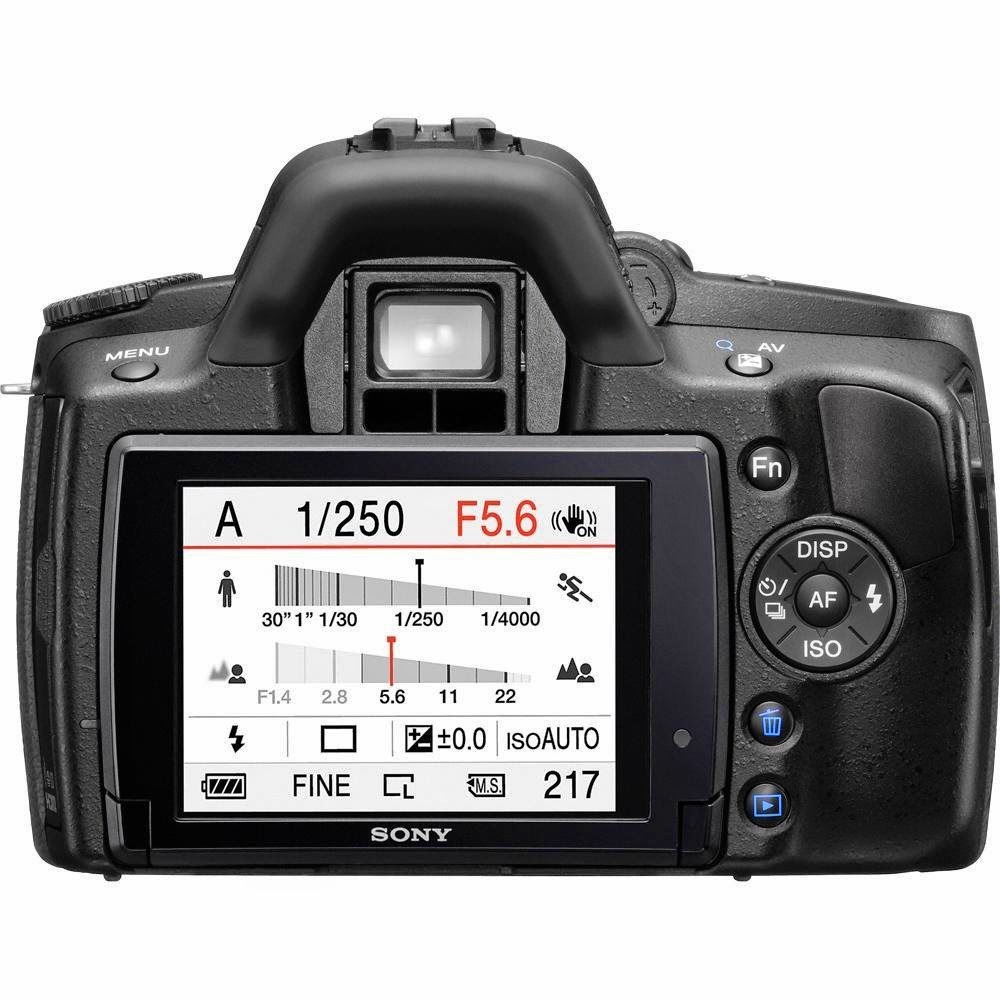Sony's latest line of entry-level SLRS have proved popular
due to their excellent on-paper specification and the inclusion of useful
features, such as an articulating screen and Quick-AF Live-View. The A390 sits
at the top of this entry level line of cameras, offering a higher pixel count
than many other similarly priced cameras in a lightweight and compact body.
Being aimed at beginners, the A390 isn't currently available without a lens and
comes bundled with their 18-55mm SAM lens as standard for a shade under £400,
which isn't a bad price for the specification. Is it good value enough to tempt
new SLR buyers from other brands? Let's take a closer look and see.
Sony Alpha A390: Features
As with Sony's other entry-level SLRs, they have chosen to implement a CCD sensor, rather than use CMOS, which may have an effect on the camera's performance at higher sensitivities. However, in good light the 14.2 megapixel resolution should be plenty enough for large reproductions of your favourite images.
Sony's Super Steady Shot system is built into the body, which means you will be able to take advantage of the benefits of image stabilisation with whatever compatible lens you mount on the camera. Whether that be an old Minolta Dynax lens, one of Sony's latest offerings, or even a lens produced by a third party manufacturer, such as Sigma or Tamron. This should allow the user to keep the weight and cost of their camera system to a minimum. A camera shake meter is visible in the bottom right corner of the viewfinder to help you make the most of the system as the steadier you are, the more it can help.
The viewfinder is a roof-mirror type providing 95% coverage of the image area. Although I found the viewfinder appears a little smaller than with some rival cameras, it does the job well enough. A total of nine focusing points are visible, which can be selected automatically by the camera, or manually if you wish to take control.
The proprietary hotshoe fitting, which is a legacy from Sony's takeover of Minolta's camera business is present on this model. Although this may not be an immediate concern for many beginners, it may mean you will need to purchase an adapter to give you a standard hotshoe for the attachment of many useful flash accessories. Third party adapters are available for a few pounds, or Sony produce their own which can cost around £100!
The 2.7inch LCD screen is a joy to use with the Live View feature, which gives very fast autofocus performance indeed for such a system. The screen can be tilted through 90degrees, allowing it to be used as a kind of waist-finder, or it can be tilted the other way for shooting above head height. I would have been nice to see a swivel feature added so that the camera could be used in portrait format more easily in these conditions, but the screen is still a useful tool all the same, saving many a dirty knee when you need to get the camera close to the ground. Although not the highest resolution screen I have ever seen, 230,400 dots is plenty enough for comfortable use along with the screen's excellent viewing angle, brightness and anti-reflection coating.
Sony Alpha A390: Features
As with Sony's other entry-level SLRs, they have chosen to implement a CCD sensor, rather than use CMOS, which may have an effect on the camera's performance at higher sensitivities. However, in good light the 14.2 megapixel resolution should be plenty enough for large reproductions of your favourite images.
Sony's Super Steady Shot system is built into the body, which means you will be able to take advantage of the benefits of image stabilisation with whatever compatible lens you mount on the camera. Whether that be an old Minolta Dynax lens, one of Sony's latest offerings, or even a lens produced by a third party manufacturer, such as Sigma or Tamron. This should allow the user to keep the weight and cost of their camera system to a minimum. A camera shake meter is visible in the bottom right corner of the viewfinder to help you make the most of the system as the steadier you are, the more it can help.
The viewfinder is a roof-mirror type providing 95% coverage of the image area. Although I found the viewfinder appears a little smaller than with some rival cameras, it does the job well enough. A total of nine focusing points are visible, which can be selected automatically by the camera, or manually if you wish to take control.
The proprietary hotshoe fitting, which is a legacy from Sony's takeover of Minolta's camera business is present on this model. Although this may not be an immediate concern for many beginners, it may mean you will need to purchase an adapter to give you a standard hotshoe for the attachment of many useful flash accessories. Third party adapters are available for a few pounds, or Sony produce their own which can cost around £100!
The 2.7inch LCD screen is a joy to use with the Live View feature, which gives very fast autofocus performance indeed for such a system. The screen can be tilted through 90degrees, allowing it to be used as a kind of waist-finder, or it can be tilted the other way for shooting above head height. I would have been nice to see a swivel feature added so that the camera could be used in portrait format more easily in these conditions, but the screen is still a useful tool all the same, saving many a dirty knee when you need to get the camera close to the ground. Although not the highest resolution screen I have ever seen, 230,400 dots is plenty enough for comfortable use along with the screen's excellent viewing angle, brightness and anti-reflection coating.


No comments:
Post a Comment